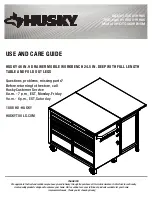
PlatinumRAID Owner’s Manual
1
RAID 3
RAID 3 provides disk striping and complete
data fault tolerance though a dedicated parity
drive. RAID 3 breaks up data into smaller
blocks, calculates parity on the blocks, and
then writes the blocks to all but one drive in
the array. The parity data created is then written
to the last drive in the array. If a single drive
fails, data is still available by computing the
inverse operation on the data and parity of the
contents corresponding strips of the surviving
member disk. RAID 3 is best for applications
that require very fast large block data transfer
rates or long data blocks
Pros: Very good large file transfer performance
Fault tolerant
Cons: Not well suited for transaction processing or other I/O request-intensive applications.
RAID 5
RAID 5 is sometimes called striping with parity
at byte level. In RAID 5, the parity information
is written to all of the drives in the subsystems
rather than concentrated on a dedicated parity
disk. If one drive in the system fails, the parity
information can be used to reconstruct the data
from that drive. All drives in the array system
can be used to seek operation at the same time,
greatly increasing the performance of the RAID
system. RAID 5 is the most often implemented
RAID algorithm in RAID arrays.
Pros: Very good general transfer performance
Fault tolerant
Cons: Can be slower then RAID 3 at large size file transfers
RAID Set
A RAID Set is a group of disks containing one or more volume sets. The MicroNet Platinum
RAID supports as follows:
• Up to five RAID Sets are supported. Please note that multiple RAID Sets on the same
disks are not supported.
• From one to five drives can be included in an individual RAID Set.
• A Volume Set must be created either on an existing RAID set or on a group of available
individual disks (disks that are not yet a part of a RAID set). If there are pre-existing
RAID sets with available capacity and enough disks for specified RAID level desired,
then the volume set will be created in the existing RAID set of the user’s choice.
2-Understanding RAID















































